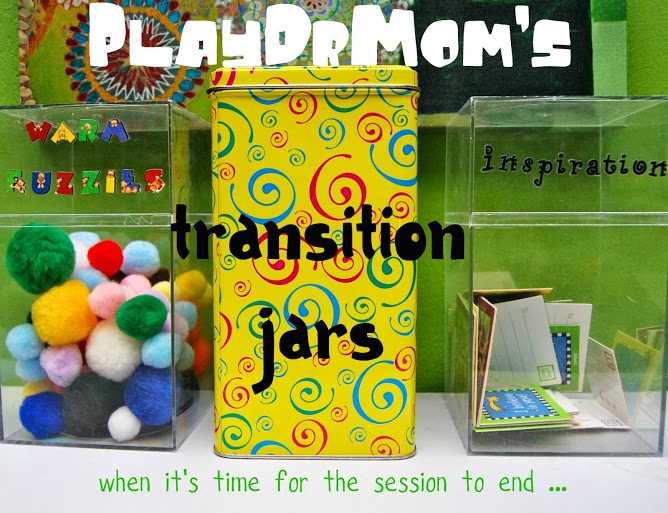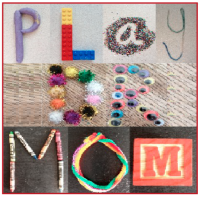How I Get Kids to Leave My Office … a transition activity
One-on-one time with an adult in a room filled with toys and very little restrictions? What kid would want to leave!!
Ending a play therapy session can be a bit tricky at times, but I have found that consistency and ritual can make it much easier.
I always give the child a five minute warning before the end of the session. This is part of the regular structuring of the session that is stressed by play therapy guru, Garry Landreth.
When the 5 minutes are up and it’s time to end the session, I get up and ask the child if they would like to pick one thing from one of my jars. I have 3 Jars.
One has pom-pons Warm Fuzzies … these are to help them remember about happy and fun times in their lives. (I got the “warm fuzzy” idea from some workshop I attended but I can’t for the life of me recall who the original source is … if you know PLEASE let me know!) The middle jar has a bunch of stickers of all different kinds. And the 3rd Jar is the “Inspiration” Jar and has “lunch box cards” … which I call to my clients “cards with special messages on them”. Each card is unique and has a tab they can lift up to read a encouraging message. The kind I use were made by Compendium Incorporated and called “Lunch Mail”. They have updated the designs on the cards but the concept is exactly the same. They now come in three different designs … I usually order one of each set (each has 24 cards with different messages) at a time.
Taking one item from one of the jars becomes a transitional ritual at the end of each session. This way they can take a part of me and their work in therapy with them. The token helps shift their attention and switch gears from therapy back to the outside world. It happens at the end of every session so it is consistent and something they can count on.
There are other therapeutic pieces that go along with this weekly activity. The child has to make a choice … actually a couple choices. He or she must choose which jar they want to take from (if any) … and which color or size; or sticker; or card. For some it’s really hard to make these decisions. The activity gives me some insight on how they make decisions and I can also see if any progress is made over time. They also have to manage handling a limit. They can only have ONE item each week. Of course many times kids will try to bargain taking one from EACH jar … or say they want to give one to a sibling/parent/friend. Since limit setting is often a key element for many of the children I see in therapy it offers a hands-on view of how the cope with boundaries. (I even had a parent get mad at me years ago when I wouldn’t let her child take more than one … very telling!)
Notice that I DO NOT have candy in any of the jars. (My clients usually do.) I tried having years ago … and sadly the kids really seemed to focus on getting the candy more than the session. Also, I don’t want to play into bad relationships with food … seeing food as a reward.
Of course you don’t have to have all three (or only 3) jars to do this type of transitional activity. I first started off with just the stickers … and then added the other two. Use what works for you and the children you work with.
If you are a therapist I’d love to hear ways in which you have your children clients transition from the play room! Leave a comment below!!!
Laura Hutchison
Latest posts by Laura Hutchison (see all)
- Hacked By GeNErAL - August 21, 2015
- ABCs of Easy Crafts for Kids - August 14, 2015
- What is Learned through PLAY - August 12, 2015
- ABCs of Playground Parkbench - August 7, 2015
- ABCs of Encourage Play - July 31, 2015

















I love this idea! I am always struggling with the transition out of the playroom. I do give the client an idea of who much time we have left but there is usually a struggle to just do “one more thing.” I will work to implement this in my playroom in the near future. Thanks for the ideas:)
Amy … I’m so glad it will be helpful for you! Thanks so much for commenting!
Hi! You may have come across this information by now, but there is a book of the story of the warm fuzzies, cute story. I don’t remember who wrote it, but it’s out there somewhere! 🙂
“Warm Fuzzies and Cold Pricklies” ….I too, attended a workshop many years ago on customer service: it was called a “Feelings” workshop! (c. 1983 or earlier)
Hi Laura,
I am currently taking a Play Therapy class and I have to present a technique. I came across your blog and love the idea of the Transition Jars. I am wondering what age group this would best work for? I am also wondering how this technique would be evaluated…how do we know that it works with the children in our sessions? Thank you so much for creating such a great site that has really helped me out.
-Nicole
I have a visual timer that really helps kids with ending. It’s from the company “Time Timer”.
Though it’s not a transitional object, I also have “Exit Cards” I have created for the end of sessions, where kids get to pick from a variety of questions on different index cards on a ring. Questions vary from “My favorite thing in today’s session was….”, to “One thing I did well in today’s session is….”, as well as questions like “One feeling I talked about today was…”, or “Something I didn’t like from today’s session is…”. Kids love these and always ask for them at the end of the session!
Hello all – I actually have a prize box but I am considering moving away from it to the idea of the three jars. I think the transitional questions are terrific! Thank you for sharing!
The warm fuzzies and cold pricklies come from the book “TA( Transactional analysis ) for kids” by Alvyn and Margeret Freed
I was just looking around on Pinterest and by some wonderful miracle I wound up on this page. I am a provisionally licensed professional counselor and work with elementary school children in the school setting. Seeing this post is so apropos. For a few weeks now, one of the kiddos I work with has been giving me quite a hard time when it comes time to leave my office. I had never considered this may be a shared experience, so it is a relief to read your post here and gain some perspective. I have been ambivalent as to what to do and am frequently scrutinizing myself on whether I am doing something wrong as she seems to enjoy her sessions with me ‘too much’ -really, I just give her my attention, I take interest in her thoughts, feelings, and experiences, and I promote her happiness and wellness. I will try the transition jars. Thank you!
Wonderful, Lindsay! I’m glad it was helpful!
The idea of inspiration quotes is a good and unique one. I am sure, not many kids will be interested to pick one of them but still it is better than having chocolate. 😀
It’s actually the favorite jar!
Hi, I learned from Dr Landreth the following technique and I find it works well to teach self control and helps with transition (although time consuming at first). At the end of session after I’ve given the 5 minute warning and my timer has gone off I say “Ok, our time is over for today.” When kids protest or ignore than I stand up and warmly say “I know you’re having fun but session is over now and it’s time to say goodbye” (or some variation). I repeat as often as necessary like a (warm but firm) broken record. I’d say 95% of the time it works. It’s time consuming at first and you’ll sound crazy if you do it in front of parents BUT IT WORKS. Over time it’s less of a process as kids learn to bring themselves under control rather than the adult doing so through raised voices, threats, or physically moving the child. Hope this is helpful
Yes! I do the same thing. It’s a great technique.
I also give them a 5 minute warning (sometimes I even do a half-way warning for kids that have a super difficult time with transition). I let them choose 2 stickers and then give them “magic” as a transitional object. The “magic” is glitter that I put a little bit on their wrists and tell them to watch out for the good/magical things that happen this week and report back next week. I do this to promote positivity/positive thinking and to also talk to kids about “creating their own magic.” It really does work. I love the idea of the warm fuzzies in a jar – will have to do this!
Love this! I once had a young client who wanted me to write her an encouraging message on the back of a business card every week when she left. She couldn’t even read yet, but it was a powerful transitional object.